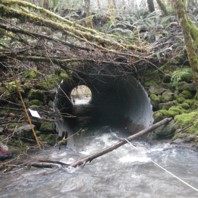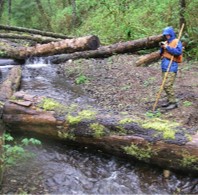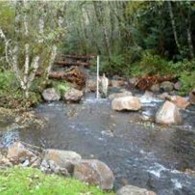HABITAT RESTORATION MONITORING
Welcome to our Stream Habitat Restoration Monitoring initiative, a vital tool for tracking the changes brought about by stream enhancement projects. This monitoring project is an outgrowth of restoration efforts that commenced on Oregon's North Coast back in 1995 and have since expanded across Western Oregon. Monitoring these restoration activities involves a structured process that begins with pre-treatment assessments of stream conditions, applying the methodology established by the Oregon Plan Monitoring Project. Post-restoration surveys are conducted to record the improvements resulting from restoration efforts and assess their long-term effectiveness.
This monitoring guides restoration biologists, helping them evaluate the success of various short- and long-term activities. The range of enhancement activities we focus on is diverse and includes:
- In-Stream Wood and Boulder Placement
- Construction of Off-Channel Habitat
- Channel Re-connections
- Culvert Replacement and Bridge Placement
- Conifer and Hardwood Riparian Plantings
- Removal of Dams and Artificial Barriers
- Road Decommissioning
By meticulously tracking the impact of these activities, we contribute to the ongoing improvement of Oregon's aquatic ecosystems and the preservation of their vital ecological functions.
Project Contact:
Matt Strickland

CULVERT REPLACEMENTS
Culverts are vital for maintaining open pathways for fish passage, influencing the health of aquatic ecosystems. The replacement of culverts is crucial to ensuring unimpeded fish movement and access to essential habitats throughout various life stages. Properly functioning culverts contribute to hydraulic efficiency, minimizing obstacles that might impede fish migration.

LARGE WOODY DEBRIS
The Aquatic Inventories Program collects information on large woody debris to monitor its role in maintaining healthy stream ecosystems and supporting fish health. Large woody debris is a natural component that influences stream dynamics, creating habitats with slower water velocities essential for juvenile fish rearing. Furthermore, it plays an important role in accumulating substrates, such as gravel, which are vital for fish spawning. By understanding and documenting the presence and characteristics of large woody debris, the program contributes to effective stream management, ensuring the preservation of these elements that are integral to the overall health and biodiversity of aquatic environments.

BOULDERS
Habitat boulders play a pivotal role in stream restoration, serving as essential components for fostering ecological health and resilience. Strategically placed boulders contribute to creating diverse microhabitats within the stream ecosystem. Their presence helps regulate water flow, enhance sediment stability, and promote the formation of pools and riffles; thereby creating a dynamic environment that supports various aquatic species. Habitat boulders also provide crucial shelter for fish and other aquatic organisms, offering protection from predators and optimal conditions for foraging. By mimicking natural stream features, these boulders contribute to the overall restoration of ecological functions, promoting biodiversity and improving the long-term sustainability of stream ecosystems.


